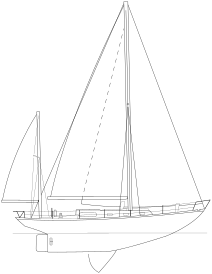Engineering:Block Island 40
 | |
| Development | |
|---|---|
| Designer | William Tripp, Jr. |
| Location | United States |
| Year | 1957–2000 |
| No. built | 22 (Mark I) 14 (Mark II) 17+ (Mark III) |
| Builder(s) | Mark I: American Boatbuilding Corporation, Beetle Boat Division Mark II: Metalmast Marine Mark III: Migrator Yachts |
| Role | Racer-Cruiser |
| Boat | |
| Boat weight | 20,000 lb (9,072 kg) |
| Draft | Mark I: 3.92 ft (1.19 m), centerboard up; 8.42 ft (2.57 m), centerboard down; Mark III: 4.16 ft (1.27 m), centerboard up; 8.83 ft (2.69 m), centerboard down |
| Hull | |
| Type | Monohull |
| Construction | Fiberglass |
| LOA | 40.0 ft (12.2 m) |
| LWL | 29.16 ft (8.89 m) |
| Beam | 11.83 ft (3.61 m) |
| Hull appendages | |
| Keel/board type | full keel with centerboard |
| Ballast | Mark I: 5,200 lb (2,359 kg); Mark III: 7,800 lb (3,538 kg) |
| Rudder(s) | keel-mounted rudder |
| Rig | |
| Rig type | Yawl rig |
| I (foretriangle height) | 46.83 ft (14.27 m) |
| J (foretriangle base) | 25.58 ft (7.80 m) |
| P (mainsail luff) | 39.50 ft (12.04 m) |
| E (mainsail foot) | 15.0 ft (4.6 m) |
| Sails | |
| Sailplan | Masthead yawl |
| Total sail area | Mark I: 752 sq ft (69.9 m2); Mark III: 738 sq ft (68.6 m2) |
| Racing | |
| PHRF | 156–186 |
The Block Island 40, also known as the Vitesse 40, is an American sailboat that was designed by William Tripp, Jr. in 1956–1957 and first built in 1957.[1]
Production
Three versions of the Block Island 40 were built: Mark I, built by the Beetle Boat division of American Boatbuilding Corporation from 1957 to the early 1960s,[2] Mark II, built by Metalmast Marine from 1974 to 1977,[2] and Mark III, built by Migrator Yachts from 1985 to at least 2000.[3][4][2][5]
The Block Island 40 design was modified by Tripp for Hinckley Yachts and sold as the Bermuda 40.
Design
The design was originally commissioned in 1956 for a Connecticut lawyer named Frederick Lorenzen, who said of wooden boats of the time, "I don't like them. They leak."[6] The design is said to be inspired by the Sparkman & Stephens yacht Finisterre.[7][4] The design is one of the first fiberglass production sailboats built.[6][4][8]
The design features a yawl sail plan, six berths, and over 6.0 ft (183 cm) of headroom ("standing headroom throughout").[9] A centerboard allowed for a minimum draft of 3 ft 11 in (1.2 m) that extended to 8 ft 15 in (2.8 m) when lowered.[6][9]
Variants
Vitesse 40 / Mark I (1957-early 1960s)
Initially, a Dutch company, Van Breems International (VBI), was to build Tripp's design as the Vitesse 40.[2] VBI never built a hull, and sold the rights to American Boatbuilding Corporation in 1957.[2] The Mark I was first known as the Vitesse 40 and later, with some modifications, renamed the Block Island 40.[8] As late as 1961, references to the Vitesse 40 were still found in VBI promotional materials.[10] The Beetle Boat Division of American Boatbuilding Corporation built a total of 22 hulls of the Mark I design.[5]
Mark II (1974–1977)
Metalmast Marine made significant changes to the design, including changes to the stern, coachroof, rudder, centerboard, and keel.[2] The keel and rudder were separated, in contrast to the full keel featured on the Mark I and Mark III. Metalmast built 14 hulls of the Mark II design.[5]
Mark III (1985-early 2000s)
In 1985, Eric Woods attempted to get Metalmast Marine to build him a customized Block Island 40. Metalmast declined and instead sold him the molds.[5] Woods founded Migrator Yachts and created the Mark III iteration. Migrator built at least 17 hulls of the Mark III design as of 2000.[3]
Operational history
The Block Island 40 found success in racing, with early wins in the 1958 Miami to Nassau race by Rhubarb[6] and the 1958 Edlu Trophy by Frederick Lorenzen's Seal.[8]
Six Block Island 40s participated in the 1960 Newport to Bermuda race, all placing in the top 11.[5][4] Hull No. 8, Alaris, won its class in the 1978 edition of the same race.[4] Hull No. 7, Bantu, won the Chicago to Mackinac Race overall in 1964, 1965, 1996, and 1997.[4]
A 1962 advertisement by American Boatbuilding Corporation references wins by Reindeer in the Annapolis to Newport Race and Marblehead to Halifax Ocean Race; Swamp Yankee in the New Bedford Whalers Race and Martha's Vineyard Ocean Race; Volta in the Newport to Cuttyhunk Race; Scylla in the Storm Trysail Race, and Alaris in the Chesapeake Bay Fall Series, but does not specify the years.[11]
References
- ↑ McArthur, Bruce (2022). "Block Island 40 sailboat". sailboatdata.com. https://sailboatdata.com/sailboat/block-island-40.
- ↑ 2.0 2.1 2.2 2.3 2.4 2.5 (in en) Cruising World, June 2000, pp. 68, https://books.google.com/books?id=do0moguj-hIC&dq=%22block+island+40%22+%22vitesse+40%22&pg=RA5-PA68
- ↑ 3.0 3.1 Nicholson, Darrell (June 23, 2000). "Beautiful Block Island 40" (in en-US). https://www.practical-sailor.com/uncategorized/beautiful-block-island-40.
- ↑ 4.0 4.1 4.2 4.3 4.4 4.5 (in en) Good Old Boat, July–August 1999, pp. 44–48
- ↑ 5.0 5.1 5.2 5.3 5.4 Nicholson, Darrell (June 14, 2000). "Block Island 40" (in en-US). https://www.practical-sailor.com/sailboat-reviews/block-island-40.
- ↑ 6.0 6.1 6.2 6.3 "Sport: Tripp Up" (in en-US). Time. February 16, 1959. ISSN 0040-781X. https://content.time.com/time/subscriber/article/0,33009,894192,00.html. Retrieved 2022-10-26.
- ↑ (in en) Good Old Boat, July–August 1999, pp. 49
- ↑ 8.0 8.1 8.2 Mitchell, Carleton (November 28, 1960). "Mold of the Future" (in en-us). p. 60. https://vault.si.com/vault/1960/11/28/41992.
- ↑ 9.0 9.1 Yachting Publishing Corporation (January 1959). Yachting. pp. 257. http://archive.org/details/YachtingJan59.
- ↑ (in en) MotorBoating. January 1961. pp. 162. https://books.google.com/books?id=C5euBnmfrX4C&dq=%E2%80%9Cvitesse+40%E2%80%9D&pg=PA162.
- ↑ (in en) Boating. Jan–Mar 1962. pp. 79. https://books.google.com/books?id=-U_toU-mQIwC&dq=%E2%80%9Cblock+island+40%E2%80%9D&pg=PA79.
 |

